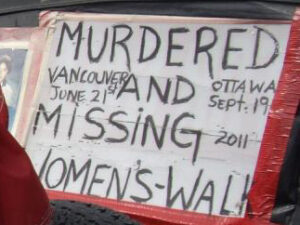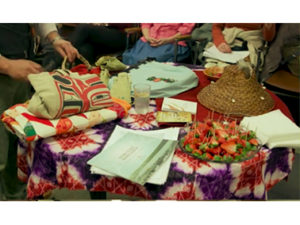2019 Reclaiming Power and Place: Final report of the national inquiry into missing and murdered Indigenous women and girls (pdf)
- 213 Calls for Justice (extracted from volume 2)
- Volume 1 (pages 1-412)
- Volume 1 (pages 413-722)
- Volume 2 (pages 1-167)
- Volume 2 (pages 167-349)
- Supplementary Report for Quebec
2019 Their Voices Will Guide Us: Student and Youth Engagement Guide (pdf)
2017 Our Women and Girls are Sacred: Interim report of the national inquiry into missing and murdered Indigenous women and girls (pdf)
2017 Walking Together: Government of Ontario, one-year progress report (pdf)
Over the past year, Ontario and Indigenous partners have come together to plan, design and implement the government’s strategy to end the cycle of violence and help ensure Indigenous women and girls can live their lives the way they deserve — with safety and respect. Ontario is making progress across the strategy’s six areas of action: supporting children, youth and families; community safety and healing; policing and justice; prevention and awareness; leadership, collaboration, alignment and accountability; and improved data and research.
2016 Amnesty International: Out of Site, Out of Mind (pdf)
Amnesty International studies the impact of resource development projects on Indigenous women and girls, and looks specifically at the situation in Fort St. John, in northern B.C..
2016 Walking Together: Ontario’s Long-Term Strategy to End Violence Against Indigenous Women (pdf)
Was released on February 23, 2016. The strategy focuses on raising awareness of and preventing violence; providing more effective programs and community services that reflect the priorities of Indigenous leaders and communities; and improving socio-economic conditions that support healing within Indigenous communities.
2016 Final report of the pre-inquiry engagement process (Government of Canada website)
This report summarizes the results of public input into the design of the National Inquiry into Missing and Murdered Indigenous Women and Girls. It highlights key issues and recommendations identified as priorities at face-to-face engagement meetings, in online surveys and through phone, email and mail submissions. This report describes the background for the inquiry and the pre-inquiry, as well as the results of the public consultation and next steps.
2016 National Inuit Submission on Pre-Inquiry (pdf)
2016 Federal-Territorial-Provincial Justice Framework to Address Violence Against Indigenous Women & Girls (pdf)
The purpose of the FPT Justice Framework is to assist FPT Ministers of Justice and Public Safety in taking a coordinated approach to work with Indigenous Peoples to stop the violence. The Framework is a strategic document, which identifies principles and priorities that will help to guide Ministers’ focus as they take action with Indigenous Peoples and other key partners to improve how the justice system prevents and responds to the violence.
2015 Update to the 2014 summary: RCMP Missing & Murdered Aboriginal Women (pdf)
2015 NGO Shadow Report (pdf)
2014 RCMP Missing & Murdered Aboriginal Women (pdf)
Summary of an RCMP led study of reported incidents of missing and murdered Indigenous women. The stated intention is that this report will guide RCMP operational planning at all levels.
2014 Violence Against Indigenous Women (VAIW): Literature review of 50 government reports and Briefing note on research outcomes (pdf)
A review of fifty reports containing over 700 recommendations related to violence against Indigenous women and girls in Canada. This research was undertaken by two volunteer researchers at Legal Strategy Coalition on Violence Against Indigenous Women (LSC) in response to previous resistance by the Government to call for a National Inquiry. Given that the Canadian Department of Justice refers to a list of existing reports to suggest that a national inquiry on MMIW is not necessary, our researchers reviewed those reports with an eye to seeing whether any recommendations of previous inquiries have been implemented. Fifty reports containing over 700 recommendations were reviewed. A preliminary assessment shows that few of the recommendations have been implemented.
2014 UNHRC: Report on the Rights of Indigenous Peoples in Canada (pdf)
2014 Inter-American Commission on Human Rights: MMIW in BC (pdf)
2013 Human Rights Watch: Those Who Took Us Away (pdf) Summary and Full Report
Report on the abusive policing and failures in protection of Indigenous women and girls in Northern British Columbia.
2012 Assembly of First Nations: Towards a National Action Plan (pdf)
2009 Native Women’s Association of Canada: Voices of our Sisters In Spirit (pdf)
NWAC, through the Sister’s In Spirit initiative received funding from the Status of Women Canada (SWC) to conduct research into missing and murdered Indigenous women from 2005 – 2010. This document presents the research including stories of the women and girls.
2007 ONWA & OFIFC: A Strategic Framework to End Violence Against Aboriginal Women (pdf)
2006 Highway of Tears Symposium Recommendations Report (pdf)
The Symposium has 33 recommendations in the following areas: Victim Prevention; Emergency Planning and Team Response; Victim Family Counselling and Support; Community Development and Support.
2004 Amnesty International: Human Rights Response to Discrimination & Violence Against Indigenous Women in Canada (pdf) Summary and Full Report
2002 Native Women’s Association of Canada: Violations of Indigenous Human Rights (pdf)
Report to the UN Special Rapporteur on the rights of Indigenous peoples on levels of violence experienced by Indigenous women in Canada.


